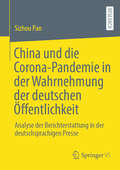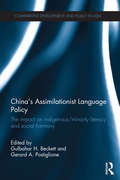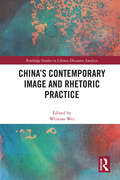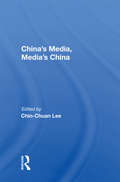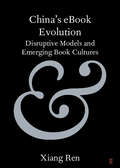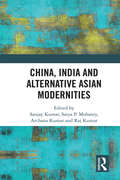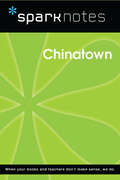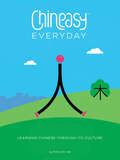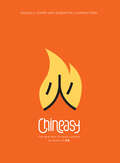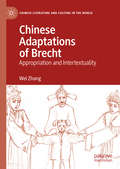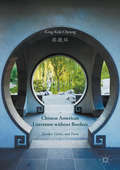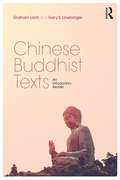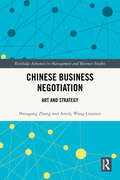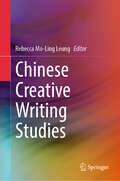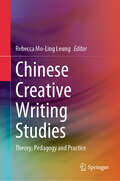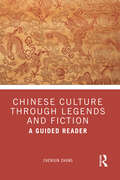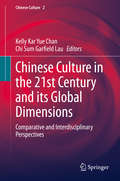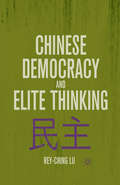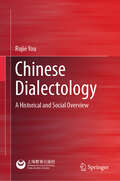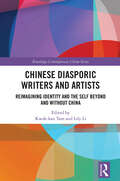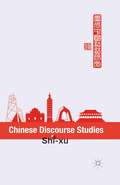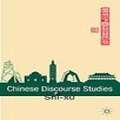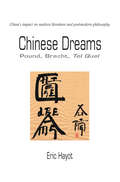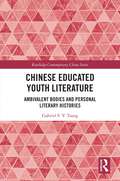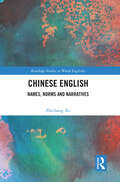- Table View
- List View
China und die Corona-Pandemie in der Wahrnehmung der deutschen Öffentlichkeit: Analyse der Berichterstattung in der deutschsprachigen Presse
by Sizhou PanIn dieser Studie wird untersucht, wie China in deutschen Leitmedien während der Corona-Pandemie wahrgenommen wurde. Mithilfe einer quantitativen und qualitativen Analyse von 10.163 Beiträgen werden zentrale Themenfelder, Diskursstrukturen und Argumentationsmuster detailliert herausgearbeitet. Die Ergebnisse zeigen, dass die Berichterstattung zwar häufig durch selektive, einseitige und ethnozentrische Tendenzen geprägt ist, dennoch auch faire und objektive Stimmen vorhanden sind. Diese Studie beleuchtet nicht nur die Vielfalt der Perspektiven, sondern auch die Herausforderungen im interkulturellen Verständnis zwischen Deutschland und China.
China's Assimilationist Language Policy: The Impact on Indigenous/Minority Literacy and Social Harmony (Comparative Development and Policy in Asia)
by Gerard A. Postiglione Gulbahar H. BeckettChina has huge ethnic minorities – over 40 different groups with a total population of over 100 million. Over time China’s policies towards minority languages have varied, changing from policies which have accommodated minority languages to policies which have encouraged integration. At present integrationist policies predominate, notably in the education system, where instruction in minority languages is being edged out in favour of instruction in Mandarin Chinese. This book assesses the current state of indigenous and minority language policy in China. It considers especially language policy in the education system, including in higher education, and provides detailed case studies of how particular ethnic minorities are being affected by the integrationist, or assimilationist, approach.
China's Contemporary Image and Rhetoric Practice (Routledge Studies in Chinese Discourse Analysis)
by Weixiao WeiChina's Contemporary Image and Rhetoric Practice presents an overview of Chinese diplomatic rhetoric, exploring how the image of China is depicted through a Western lens and introducing a profound shift in domestic perspectives of this image. This reader reveals new sites for Chinese rhetoric to deepen scholarship in the relevant studies of Chinese literature, Chinese discourse analysis, Chinese sociology, Chinese politics and so on. These chapters have been cherry-picked for their contributions to the field, and may facilitate the expanding development of Chinese studies. This book is a valuable reference for scholars, researchers and graduate or postgraduate students in Chinese linguistic and social studies.
China's Media, Media's China
by Chin-Chuan LeeThis book explores the rapidly evolving conditions of political communication in China. It examines how ideology and professional roles affect both scholarly and journalistic understanding of China. The book offers insights into Chinese journalism and Sino-American relations. .
China's eBook Evolution: Disruptive Models and Emerging Book Cultures (Elements in Publishing and Book Culture)
by Xiang RenThis Element explores the changing landscape of eBook businesses and cultures in China in the past two decades and examines how disruptive innovation and the platform economy have transformed one of the world's largest book markets. Through an evolutionary perspective, this Element documents and analyses the emergence, growth, and refinement of disruptive models in three areas of trade publishing, including free eBook developments, digital self-publishing, and platformed social reading. It offers a critical account of the complex interplay between emerging technologies, business innovations, and book cultures and conceptualises China's eBook evolution as both a part of global digital publishing transformation in the platform age and an embodiment of local dynamics in a transitional society. This Element is essential for scholars, students, publishers, and the interested publics to understand China's digital publishing innovations and their global implications.
China, India and Alternative Asian Modernities
by Satya P. Mohanty Sanjay Kumar Archana Kumar Raj KumarThe conception of modernity as a radical rupture from the past runs parallel to the conception of Europe as the primary locus of global history. The essays in this volume contest the temporal and spatial divisions—between past and present, modernity and tradition, and Europe’s progress and Asia’s stasis—which the conventional narrative of modernity creates. Drawing on early modern Chinese and Indian history and culture instead, the authors of the book explore the provenance of modernity beyond the west to see it in a transcultural and pluralistic light. The central argument of this volume is that modernity does not have a singular core or essence—a causal centre. Its key features need to be disaggregated and new configurations and combinations imagined. By studying the Bhakti movement, Confucian democracy, and the maritime and agrarian economies of China and India, this book enlarges the terms of debate and revisits devalued terms and concepts like tradition, religion, authority, and rural as resources for modernity. This book will be of great interest to researchers and academicians working in the areas of history, Sociology, Cultural Studies, literature, geopolitics, South Asian and East Asian Studies.
Chinatown (SparkNotes Film Guide)
by SparkNotesChinatown (SparkNotes Film Guide) Making the reading experience fun! SparkNotes Film Guides are one-stop guides to great works of film–masterpieces that are the foundations of filmmaking and film studies. Inside each guide you&’ll find thorough, insightful overviews of films from a variety of genres, styles, and time periods. Each film guide contains:Information about the director and the context in which the film was made Thoughtful analysis of major characters Details about themes, motifs, and symbols Explanations of the most important lines of dialogue In-depth discussions about what makes a film so remarkable SparkNotes Film Guides are an invaluable resource for students or anyone who wants to gain a deeper understanding of the great films they know and love.
Chineasy Everyday: Learning Chinese Through Its Culture
by ShaoLanThe New Way to Read ChineseShaoLan Hsueh, a Taiwanese entrepreneur based in London, couldn’t find an effective way to teach her children Chinese, so she developed a groundbreaking visual method to make reading characters fun and easy. By learning the most commonly occurring characters—the building blocks of the entire language—readers of all ages can swiftly grasp basic concepts and words.Chineasy Everyday teaches more than four hundred of the most useful Chinese characters, phrases, and sentences. Organized into eleven themes that reflect daily life, this book brings the stories and myths behind the characters to life, providing a unique perspective into Chinese history and culture.“These cute images make reading Chinese characters ‘Chineasy.’”—NPR’s “Code Switch” blog“In her delightful book...Hsueh offers an inspired approach to learning more than four hundred Chinese characters.”—San Francisco Chronicle blog
Chineasy: The Easy Way to Learn Chinese
by ShaoLan HsuehChinese is considered one of the most difficult languages to master. However, using the Chineasy system, anyone can begin to understand and read Chinese. It works by transforming Chinese characters into illustrations to make them easy to remember. This book teaches the key characters on which the language is built and how these characters can be combined to form more complex words and phrases. Learning Chinese has never been this simple or more fun!
Chinese Adaptations of Brecht: Appropriation and Intertextuality (Chinese Literature and Culture in the World)
by Wei ZhangThis book examines the two-way impacts between Brecht and Chinese culture and drama/theatre, focusing on Chinese theatrical productions since the end of the Cultural Revolution all the way to the first decades of the twenty-first century. Wei Zhang considers how Brecht’s plays have been adapted/appropriated by Chinese theatre artists to speak to the sociopolitical, economic, and cultural developments in China and how such endeavors reflect and result from dynamic interactions between Chinese philosophy, ethics, and aesthetics, especially as embodied in traditional xiqu and the Brechtian concepts of estrangement (Verfremdungseffekt) and political theatre. In examining these Brecht adaptations, Zhang offers an interdisciplinary study that contributes to the fields of comparative drama/theatre studies, intercultural studies, and performance studies.
Chinese American Literature without Borders: Gender, Genre, and Form
by King-Kok CheungThis book bridges comparative literature and American studies by using an intercultural and bilingual approach to Chinese American literature. King-Kok Cheung launches a new transnational exchange by examining both Chinese and Chinese American writers. Part 1 presents alternative forms of masculinity that transcend conventional associations of valor with aggression. It examines gender refashioning in light of the Chinese dyadic ideal of wen-wu (verbal arts and martial arts), while redefining both in the process. Part 2 highlights the writers' formal innovations by presenting alternative autobiography, theory, metafiction, and translation. In doing so, Cheung puts in relief the literary experiments of the writers, who interweave hybrid poetics with two-pronged geopolitical critiques. The writers examined provide a reflexive lens through which transpacific audiences are beckoned to view the "other" country and to look homeward without blinders.
Chinese Buddhist Texts: An Introductory Reader
by Graham Lock Gary S. LinebargerThe influence of Buddhism on the Chinese language, on Chinese literature and on Chinese culture in general cannot be overstated, and the language of most Chinese Buddhist texts differs considerably from both Classical and Modern Chinese. This reader aims to help students develop familiarity with features of Buddhist texts in Chinese, including patterns of organization, grammatical features and specialized vocabulary. It also aims to familiarize students with the use of a range of resources necessary for becoming independent readers of such texts. Chinese Buddhist Texts is suitable for students who have completed the equivalent of at least one year’s college level study of Modern Chinese and are familiar with roughly one thousand of the commonest Chinese characters. Previous study of Classical Chinese would be an advantage, but is not assumed. It is an ideal textbook for students taking relevant courses in Chinese studies programs and in Buddhist studies programs. However, it is also possible for a student to work through the reader on his or her own. Further online resources are available at: lockgraham.com
Chinese Business Negotiation: Art and Strategy (Routledge Advances in Management and Business Studies)
by Shougang Zhang Amily Wang GuenierChinese Business Negotiation offers readers a comprehensive insight into Chinese negotiation principles, shaped by centuries of cultural tradition and contemporary global business dynamics. Unlike competitive or zero-sum approaches, Chinese negotiation emphasizes harmony, trust, and long-term partnerships. This book introduces key concepts such as Shi (strategic advantage through interdependence), ethical wealth-seeking, and human-centered, empathy-driven communication.Structured across nine chapters, the book blends historical wisdom with modern business applications, providing practical frameworks for navigating cross-cultural negotiations. Readers will gain an understanding of strategic planning, flexible adaptation, and balanced communication in high-stakes deal-making. Case studies—including Lenovo’s acquisition of IBM’s PC division, SANY’s acquisition of Germany’s Putzmeister, Midea’s acquisition of KUKA Robotics, and Tesla’s negotiations in China—illustrate how these principles drive success in real-world scenarios.This book serves as a valuable resource for business professionals, scholars, and policymakers seeking to deepen their understanding of Chinese negotiation culture. By bridging Eastern and Western approaches, it equips readers with the tools to foster cooperative, mutually beneficial agreements in an increasingly interconnected world.
Chinese Creative Writing Studies
by Leung Rebecca Mo-LingThis book introduces Chinese creative writing to the English-speaking world, considering various aspects of literary and creative theories in research in Chinese writing. It covers recent trends such as cross-media practices, pedagogy in creative writing in China, Taiwan and Hong Kong, specifically, and looks at how Chinese classical culture brings new interpretations to creative writing within a global context. Consisting of 14 chapters by established scholars and experts, writers, and poets working in various genres within the Chinese writing tradition, the book presents data accrued from personal reflections, classroom teaching, video games, museum studies, radio dramas, TV series, and cyber-literature. The book includes leading Chinese leading scholars’ reflections on research and the field, providing an omnibus perspective on theories of creative writing. It focuses on the interconnection between Chinese creative writing and pedagogy and examines different writer-training methods in Mainland China, Hong Kong, and Taiwan, offering a comparative perspective that deepens the understanding of institutional effects on the development of creative writing. It unpacks the interaction between Chinese creative writing and multimedia and ascertains the possibilities of incorporating media studies into writing practices. It also presents new interpretations of Chinese classical culture assets to new creative or literary manuscripts, such as TV series adaptation and Internet literature. Relevant to researchers, teachers, and students working Chinese creative writing and Chinese literature, it is also a landmark text in exposing English-speaking creative writing scholars to the wealth of Chinese creative writing, in English.
Chinese Creative Writing Studies: Theory, Pedagogy and Practice
by Rebecca Mo-Ling LeungThis book charts the development of creative writing, bringing it from China to the world. As the second volume of Chinese Creative Writing Studies, the first of which introduces Chinese creative writing to English-speaking readers, this book expands on the first in further developing theories and research on creative writing pedagogy in the Chinese context, and in Hong Kong particular, looking at creative writing within cross-media practices, and the implications for creative writing in global contexts. The volume does so by presenting both local and international voices to expand the horizon of Chinese creative writing development. Structured in four parts, the book begins with leading Chinese scholars' reflections on research and field. The second part focuses on the interlinkages between creative writing and pedagogy in Hong Kong. The third section discusses poetic thinking and therapeutic writing to highlight their relationship with the personal and community. Lastly,the book takes a global perspective to examine the pedagogy and practice of creative writing through interviews with leaders in the field. It is relevant to researchers, teachers, and students interested in creative writing, particularly Chinese creative writing, but also those working in comparative contexts, both culturally, and in terms of cross-media perspectives.
Chinese Culture Through Legends and Fiction: A Guided Reader
by Zhenjun ZhangThis is a collection of selected and translated Chinese legends and tales arranged under specific topics important to Chinese culture, with an introduction and reading guide for each piece.Comprised of 4 parts covering Confucian culture, Daoist culture, Buddhist culture and topics beyond the Three Teachings, the sources featured in this anthology include legends, fictional works, historical texts, as well as philosophical texts of ancient China, ranging from the Han 漢dynasty (206 BCE-220 CE) to the Qing 清dynasty (1644-1911).Helping readers learn about Chinese customs, traditions, and values by immersing them in the wonderful world of traditional China, with the compelling legends and tales revealing the fascinating meshwork of Chinese culture, this book is an invaluable text for students and scholars of Chinese literature, culture and history, as well as general readers with an interest in China.
Chinese Culture in the 21st Century and its Global Dimensions: Comparative and Interdisciplinary Perspectives (Chinese Culture #2)
by Kelly Kar Yue Chan Chi Sum Garfield LauThis book investigates the internationalization of Chinese culture in recent decades and the global dimensions of Chinese culture from comparative and interdisciplinary perspectives. It covers a variety of topics concerning the contemporary significance of Chinese culture in its philosophical, literary and artistic manifestations, including literature, film, performing arts, creative media, linguistics, translations and philosophical ideas. The book explores the reception of Chinese culture in different geographic locations and how the global reception of Chinese culture contrasts with the local Chinese community. The chapters collectively cover gender studies and patriarchal domination in Chinese literature in comparison to the world literature, explorations on translation of Chinese culture in the West, Chinese studies as an academic discipline in the West, and Chinese and Hong Kong films and performances in the global context. The book is an excellent resource for both scholars and students interested in the development of Chinese culture on the global stage in the 21st Century.
Chinese Democracy and Elite Thinking: How Elite Thinking On China's Development And Change Influences Chinese Practice Of Democracy (1839--the Current Time).
by Rey-Ching LuWill China become a multiparty democracy? The author projects that within the next twenty years there China will march on the path of democratization.
Chinese Dialectology: A Historical and Social Overview
by Rujie YouThis book explores one of the richest dialect families in the world: Chinese dialects. It covers all aspects of Chinese dialectology, from descriptive investigations, to dialect geography and philology, history, variation, language contact and sociolinguistics, and also includes a unique bibliography of dialect works by Western missionaries, explaining profound theories in simple language with colorful examples from all over China. Based on a unique framework and focusing on what other work on Chinese dialectology lacks, it combines a theoretical perspective with field research, and also links Western theory to the Chinese dialect tradition. This book is a breath of fresh air, providing new data as well as a bibliography of dialect translations of the Old and New Testaments not available elsewhere. Re-assessing old views and offering new perspectives based on rigorous research, it is an indispensable resource for researchers.
Chinese Diasporic Writers and Artists: Reimagining Identity and the Self Beyond and Without China (Routledge Contemporary China Series)
by Kwok-Kan Tam Lily LiThis book presents new and original essays that capture the enigmatic and intriguing personal and imagined worlds of Chinese writers and artists in diaspora in the twentieth and twenty-first centuries.Including chapters on artist-writers such as Gao Xingjian, Dai Sijie, Ha Jin and Hong Ying, Tyrus Wong, and Shen Wei, the book explores personal cross-cultural experiences through their literary and other artistic works, reflecting on their cultural identity, their native home, and their new home, the past and the present. By writing, filming, and painting about their diaspora/diasporic experience, they are writing about their selves and the traumatic experience many of them have gone through in forgetting the past, forgiving the damage, and foreshadowing a future by re-visioning their selves. Their experience represents a generation’s quest for an identity of being Chinese but culturally distanced from China.As a study of cross-cultural human experience through the lens of literature, film, and other arts, this book will not only appeal to students and scholars of Chinese diaspora studies, it will also appeal to those with an interest in Chinese literature, film, and culture.
Chinese Discourse Studies
by S. xuChinese Discourse Studies presents an innovative and systematic approach to discourse and communication in contemporary China. Incorporating Chinese philosophy and theory, it offers not only a distinct cultural paradigm in the field, but also a culturally sensitive and effective tool for studying Chinese discourses.
Chinese Discourse Studies
by Shi-XuChinese Discourse Studies presents an innovative and systematic approach to discourse and communication in contemporary China. Incorporating Chinese philosophy and theory, it offers not only a distinct cultural paradigm in the field, but also a culturally sensitive and effective tool for studying Chinese discourses.
Chinese Dreams Pound, Brecht, Tel quel
by Eric HayotChina’s profound influence on the avant-garde in the 20th century was nowhere more apparent than in the work of Ezra Pound, Bertolt Brecht, and the writers associated with the Parisian literary journal Tel quel. Chinese Dreams explores the complex, intricate relationship between various “Chinas”—as texts—and the nation/culture known simply as “China”—their context—within the work of these writers. Eric Hayot calls into question the very means of representing otherness in the history of the West and ultimately asks if it might be possible to attend to the political meaning of imagining the other, while still enjoying the pleasures and possibilities of such dreaming. The latest edition of this critically acclaimed book includes a new preface by the author.
Chinese Educated Youth Literature: Ambivalent Bodies and Personal Literary Histories (ISSN)
by Gabriel F. TsangThis book explores the literary history of the zhiqing, Chinese educated youth, during the liberal 1980s era of the PRC.By incorporating personal experiences, literary representation, shared history, and theory, it argues that attention to bodies’ physical/physiological condition, as represented in their fictional works, can reveal their attitudes toward the shifting and anomalous socio-political environments, both at the time of their rustication in Mao Zedong’s era and at the time of writing about their experiences in Deng Xiaoping’s cities. It highlights the ideological transformation of educated youth writers’ malleable fictional bodies, which preserved and encoded their private ambivalence and dynamic compromises with political and literary dilemmas. By studying these "fictional bodies," this book deciphers the specific significance of labor, hunger, disability, and sexuality, negating the simplification of the fabricated embodiment as only containing and delivering iconoclastic spirit, sincere patriotism, personal struggle, socialist ideological control, and feminine self-consciousness.Exploring the community of Chinese educated youth, of which Xi Jinping was one, this will be a valuable resource to students and scholars of Comparative literature, Modern Chinese literature, and Modern Chinese history.
Chinese English: Names, Norms, and Narratives (Routledge Studies in World Englishes)
by Zhichang XuThis book offers a distinct exploration of Chinese English – which has the largest rising population of speakers in the World Englishes (WE) family. Xu focuses on the fundamental issues of "names" and "norms" that are closely related to Chinese English and the "narratives" of the speakers of Chinese English. In addition to current approaches to WE research, this book proposes a novel theoretical and analytical framework based on classical Chinese and Western philosophies. The volume has an empirical basis, drawing upon interview and questionnaire survey data from proficient speakers of Chinese English. It is also based on an extensive review of the relevant literature on both WE and Chinese English, and it draws upon the author’s research experience of over two decades on the subject. This is the third research book on Chinese English that the author has contributed to WE literature and it will be a valuable read for students and scholars alike.
